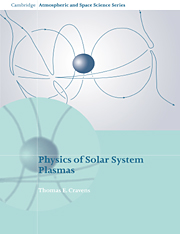Book contents
- Frontmatter
- Contents
- Preface
- Physical constants
- Vector calculus identities
- 1 Space physics
- 2 Introduction to kinetic theory
- 3 Single particle motion and geomagnetically trapped particles
- 4 Magnetohydrodynamics
- 5 Solar physics
- 6 The solar wind
- 7 The solar wind interaction with planets and other solar system bodies
- 8 The magnetosphere
- Appendix
- Index
5 - Solar physics
Published online by Cambridge University Press: 26 October 2009
- Frontmatter
- Contents
- Preface
- Physical constants
- Vector calculus identities
- 1 Space physics
- 2 Introduction to kinetic theory
- 3 Single particle motion and geomagnetically trapped particles
- 4 Magnetohydrodynamics
- 5 Solar physics
- 6 The solar wind
- 7 The solar wind interaction with planets and other solar system bodies
- 8 The magnetosphere
- Appendix
- Index
Summary
The Sun is a star. As stars go, the Sun is rather cool and small and has the gross characteristics listed in Table 5.1. The Sun is the source of virtually all energy in our solar system, including the Earth. Solar radiation heats our atmosphere and provides the light needed to sustain life on our planet. The Sun is also the source of space plasmas throughout the solar system. For example, solar extreme ultraviolet (EUV) radiation is largely responsible for the existence of planetary ionospheres via the photoionization of atoms and molecules in the upper atmospheres of the planets. The solar wind plasma is really an extension of the solar corona out into interplanetary space. The Sun is also, naturally, the source of solar activity. Solar activity refers to both short-term and long-term temporal variations in the solar atmosphere (and hence in the solar wind) that create changes in the Earth's plasma environment (i.e., geomagnetic activity). We will deal with the effects of solar activity on the Earth later.
The field of solar physics has advanced dramatically during the past few decades, due to observations made by increasingly sophisticated ground- and space-based observatories, including NASA's OGO, Skylab, and Solar Maximum missions and the NASA/ESA SOHO (Solar and Heliospheric Observatory) mission, and due to theoretical developments in the areas of stellar nuclear physics, stellar radiative transfer, and solar MHD.
- Type
- Chapter
- Information
- Physics of Solar System Plasmas , pp. 159 - 190Publisher: Cambridge University PressPrint publication year: 1997
- 1
- Cited by

